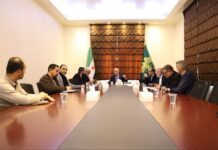
“We were stumbling over the corpses of our neighbors, relatives, and children as we tried to escape from Al-Dhiyabiya,” said a survivor of the bloody massacres of Al-Dhiyabiya and Al-Husseiniyah, which occurred in the southern suburbs of Damascus, in October 2013.
The massacre began when Shiite militias from Iraq and Lebanon besieged the two towns for three days, then under cover from Assad regime artillery and machine gun fire, began storming the villages on the morning of Friday, October 11, 2013, chanting sectarian slogans, gathering large numbers of residents, torturing them, and then executing them by firing squad, rifle bayonets and knives.
Witnesses report that the two main groups were Lebanese Hezbollah and Iraqi Abu Al-Fadl Al-Abbas Brigade both of whom shouted sectarian slogans such as, “At your service, O Hussein,” “O killers of Hussein,” and “At your command, O Zainab,” as they slaughtered the people.
Members of Hezbollah and the Abu Al-Fadl Al-Abbas Brigade pursued the people who tried to escape from Al-Dhiyabiyah, killing a number of them as they fled, before beginning the process of burning houses and arresting huge numbers of women and children who were then murdered.
There were 130 people killed by Iranian-backed Assad-aligned militias that day, including children, women, and elderly. The militias left piles of bodies lying in the streets and prevented the wounded from being treated or the dead from being buried for more than a day. They also burnt many of the homes, possibly destroying evidence of other crimes and murdered residents, and preventing any who escaped from being able to return.
Louay Al-Miqdad, a media and political coordinator of the Free Syrian Army (FSA) in the region at the time, told the press that Iraqi militias participated in the massacre and that the victims were field-executed or slaughtered with blades, explaining that orders to kill the Syrian civilians came from Tehran.
Most of the residents of the Al-Husseiniyah area were Palestinians who had sought refuge in Syria years ago, one of the survivors, Hisham said: “No one helped us, and the FSA alone cannot repel the attack of these monsters.”
Ten years since the massacre have passed, and Assad and his Iranian allies are still carrying out their crimes without accountability. Iran is trying to erase the country’s history, change its demographics, exploit the apathy of the international community, and influence with Assad’s government to continue the spread of sectarianism in Syria.








